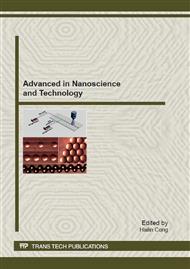[1]
S. Motojima, S. Hoshiya, Y. Hishikawa, Electromagnetic wave absorption properties of carbon microcoils/PMMA composite beads in W bands, Carbon 41 (2003) 2653-2689.
DOI: 10.1016/s0008-6223(03)00292-6
Google Scholar
[2]
Z.M. Shen, M. Ge, D.L. Zhao, Microwave absorbing properties of carbon microcoils, New Carbon Mater. 20 (2005) 289-293.
Google Scholar
[3]
D.L. Zhao, Z.M. Shen, Preparation and microwave absorption properties of carbon nanocoils. Mater. Lett. 62 (2008) 3704-3706.
DOI: 10.1016/j.matlet.2008.04.032
Google Scholar
[4]
Y. Kato, N. Adachi, T. Okuda, T. Yoshida, S. Motojima, T. Tsuda, Evaluation of induced electromotive force of a carbon micro coil, Jpn. J. Appl. Phys. 42 (2003) 5035-5037.
DOI: 10.1143/jjap.42.5035
Google Scholar
[5]
S. Motojima, X. Chen, S. Yang, M. Hasegawa, Properties and potential applications of carbon microcoils/nanocoils, Diamond Related Mater. 13 (2004) 1989-(1992).
DOI: 10.1016/j.diamond.2004.06.020
Google Scholar
[6]
K.L. Williams, A.B. Eriksson, R. Thorslund, J. Köhler, M. Boman, L. Stenmark, The electrothermal feasibility of carbon microcoil heaters for cold/hot gas microthrusters, J. Micromech. Microeng. 16 (2006) 1154-1161.
DOI: 10.1088/0960-1317/16/7/007
Google Scholar
[7]
X. Chen, S. Zhang, D.A. Dikin, W. Ding, R.S. Ruoff, L. Pan, Y. Nakayama, Mechanics of a Carbon Nanocoil, Nano Lett. 3 (2003) 1299-1304.
DOI: 10.1021/nl034367o
Google Scholar
[8]
D.J. Bell, Y. Sun, L. Zhang, L.X. Dong, B.J. Nelson, D. Grützmacher, Three-dimensional nanosprings for electromechanical sensors, Sensors Actuat. A 130-131 (2006) 54-61.
DOI: 10.1016/j.sna.2005.10.057
Google Scholar
[9]
T. Katsuno, X. Chen, S. Yang, S. Motojima, Relationship of a carbon microcoil and carbon microcoil tactile sensor element in electrical properties, Diamond Related Mater. 16 (2007) 1000-1003.
DOI: 10.1016/j.diamond.2007.01.035
Google Scholar
[10]
K. Yoshimura, K. Nakano, T. Miyake, Y. Hishikawa, C. Kuzuya, T. Katsuno, S. Motojima, Effect of compressive and tensile strains on the electrical resistivity of carbon microcoil/silicone-rubber composites, Carbon 45 (2007) 1997-(2003).
DOI: 10.1016/j.carbon.2007.06.001
Google Scholar
[11]
Y.B. Zhu, L. Zhang, L.T. Guo, D.H. Xiang, Study on the impedance of aligned carbon microcoils embedded in silicone rubber matrix, Chin. Phys. B 19 (2010) 126102.
DOI: 10.1088/1674-1056/19/12/126102
Google Scholar
[12]
D. Banerjee, A. Jha, K.K. Chattopadhyay, Efficient field emission from coiled carbon nano/microfiber on copper substrate by dc-PECVD, Appl. Surf. Sci. 256 (2010) 7516- 7521.
DOI: 10.1016/j.apsusc.2010.05.099
Google Scholar
[13]
K.L. Williams, J. Köhler, M. Boman, Fabrication and mechanical characterization of LCVD-deposited carbon micro-springs, Sensors Actuat. A 130-131 (2006) 358-364.
DOI: 10.1016/j.sna.2005.10.022
Google Scholar
[14]
Q. Liu, Z.M. Cui, Z. Ma, S.W. Bian, W.G. Song, Carbon materials with unusual morphologies and their formation mechanism, J. Phys. Chem. C 111 (2007) 12420-12424.
DOI: 10.1021/jp073240a
Google Scholar
[15]
T. Hayashida, L. Pan, Y. Nakayama, Mechanical and electrical properties of carbon tubule nanocoils, Physica B 323 (2002) 352-353.
DOI: 10.1016/s0921-4526(02)01002-5
Google Scholar
[16]
N.K. Chang, S.H. Chang, Determining Mechanical Properties of Carbon Microcoils Using Lateral Force Microscopy, IEEE Transact. Nanotechn. 7 (2008) 197-201.
DOI: 10.1109/tnano.2007.915004
Google Scholar
[17]
J.Y. Shen, Z.J. Chen, N.L. Wang, W.J. Li, L.J. Chen, Electrical properties of a single microcoiled carbon fiber, Appl. Phys. Lett. 89 (2006) 153132.
DOI: 10.1063/1.2360932
Google Scholar
[18]
W.J. Li, H.T. Xu, Y.C. Guo, L.J. Chen, Vapor-liquid-solid-solid growth mechanism of Carbon micro-coils, Acta Physico-Chimica Sinica 22 (2006) 768-770.
DOI: 10.3866/pku.whxb20060625
Google Scholar
[19]
C. Kuzuya, W. In-Hwang, S. Hirako, Y. Hishikawa, S. Motojima, Preparation, morphology, and growth mechanism of Carbon nanocoils, Chem. Vap. Deposition 8 (2002) 57-62.
DOI: 10.1002/1521-3862(20020304)8:2<57::aid-cvde57>3.0.co;2-y
Google Scholar
[20]
P.E. Anderson, N.M. Rodringuez, Influence of the support on the structural characteristics of Carbon nanofibers produced from the metal-catalyzed decomposition of Ethylene, Chem. Mater. 12 (2000) 823-830.
DOI: 10.1021/cm990582n
Google Scholar
[21]
R.L. Vander Wal, T.M. Ticich, V.E. Curtis, Substrate-support interactions in metal-catalyzed carbon nanofiber growth, Carbon 39 (2001) 2277-2289.
DOI: 10.1016/s0008-6223(01)00047-1
Google Scholar
[22]
K. Shibagaki, S. Motojima, Y. Umemoto, Y. Nishitani, Outermost surface microstructure of as-grown, heat-treated and partially oxidized carbon microcoils, Carbon 39 (2001) 1337-1342.
DOI: 10.1016/s0008-6223(00)00231-1
Google Scholar
[23]
J.A. Menendez, E.M. Menendez, M.J. Iglesias, A. Garcia, J.J. Pis, Modification of the surface chemistry of active carbons by means of microwave-induced treatments, Carbon 37 (1999) 1115-1121.
DOI: 10.1016/s0008-6223(98)00302-9
Google Scholar
[24]
N.F. Mott, Conduction in non-crystaline materials III. localized states in a pesudogap and near extremilities of conduction and valence bands, Philos. Mag. 19 (1969) 835.
DOI: 10.1080/14786436908216338
Google Scholar
[25]
A. Tibrewala, E. Peiner, R. Bandorf, S. Biehl, H. Lüthje, Transport and optical properties of amorphous carbon and hydrogenated amorphous carbon films, Appl. Surf. Sci. 252 (2006) 5387-5390.
DOI: 10.1016/j.apsusc.2005.12.046
Google Scholar
[26]
B.A. Samuel, R. Rajagopalan, H.C. Foley, M.A. Haque, Temperature effects on electrical transport in semiconducting nanoporous carbon nanowires, Nanotechnology 19 (2008) 275702.
DOI: 10.1088/0957-4484/19/27/275702
Google Scholar
[27]
P.W. Barone, S. Baik, D.A. Heller, M.S. Strano, Near-infrared optical sensors based on single-walled carbon nanotubes, Nature Mater. 4 (2005) 86-92.
DOI: 10.1038/nmat1276
Google Scholar
[28]
S.X. Lu, B. Panchapakesan, Photoconductivity in single wall carbon nanotube sheets, Nanotechnology 17 (2006) 1843-1850.
DOI: 10.1088/0957-4484/17/8/006
Google Scholar
[29]
G.T. Liu, Z. Liu, Y.C. Zhao, K.H. Zheng, H.B. Huang, W.J. Ma, C.Z. Gu, L.F. Sun, S.S. Xie, Large photocurrent generated by a camera flash in single-walled carbon nanotubes, J. Phys. D: Appl. Phys. 40 (2007) 6898-6901.
DOI: 10.1088/0022-3727/40/22/007
Google Scholar
[30]
Y. Liu, S.X. Lu, B. Panchapakesan, Alignment enhanced photoconductivity in single wall carbon nanotube films, Nanotechnology 20 (2009) 035203.
DOI: 10.1088/0957-4484/20/3/035203
Google Scholar
[31]
A. Lafuma, D. Quéré, Superhydrophobic states, Nature Mater. 2 (2003) 457-460.
DOI: 10.1038/nmat924
Google Scholar
[32]
Y.Z. Long, M.M. Li, W.M. Sui, Q.S. Kong, L. Zhang, Electrical, dielectric and surface wetting properties of multi-walled carbon nanotubes/nylon-6 nanocomposites, Chin. Phys. B 18 (2009) 1221-1226.
DOI: 10.1088/1674-1056/18/3/063
Google Scholar
[33]
X.H. Zhou, G.L. Cui, L.J. Zhi, S.S. Zhang, Large-area helical carbon microcoils with superhydropho-bicity over a wide range of pH values, New Carbon Mater. 22 (2007) 1-6.
DOI: 10.1016/s1872-5805(07)60005-5
Google Scholar
[34]
A.B.D. Cassie, S. Baxter, Wettability of porous surfaces, Trans. Faraday Soc. 40 (1944) 546-551.
DOI: 10.1039/tf9444000546
Google Scholar


